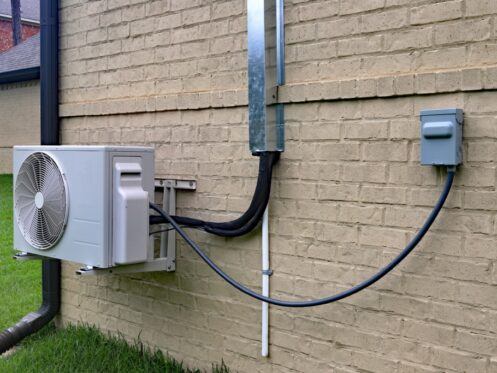Ductless mini-split systems have become popular as more people look to upgrade to more efficient cooling and heating options. Ductless mini-splits offer the efficiency of heat pumps and the added cost-saving benefits of a zoned system. However, you will only realize these benefits if you install a correctly sized system. Discover what you need to know about mini-split sizing and what factors need to be considered when determining the system you need.
What Does Size Mean?
It is important to understand what’s meant by the size of your ductless mini-split. Most air handlers are about the same physical size, usually around 12 inches tall, about 30 inches long, and about 9 inches deep. They are typically mounted on the inside wall of your home and deliver heated or cooled air. The outside condenser unit is usually around 2 feet tall, about 1 foot deep, and nearly 3 feet wide. These units are typically installed in your backyard or on the side of your house.
However, what HVAC professionals mean when talking about the size of a system is its heating and cooling capacity. This is measured in British thermal units (BTUs). A single BTU is the amount of heat that is needed to raise one pound of water by one degree Fahrenheit. For example, when a heat pump is rated at 5,000 BTU, that means it will transfer 5,000 BTUs of heat energy every hour that it runs.
Why Size Is Critical for Your Comfort
Size is critical for two primary reasons. First, an improperly sized system will either not transfer enough heat energy because it’s undersized, or it will have too much capacity, which causes short cycling. Short cycling is when the system turns on and then off quickly because it heats or cools the space too fast. Both of these sizing problems have the same result. Your house will never get to the desired temperature. An additional issue with a system that is too large and short cycles is that the mini-split cannot remove humidity properly. Your home will be humid and uncomfortable as a result.
The second factor is the wear on your system. Both over- and under-sized systems experience excessive strain. This results in more rapid wear on the system and component failure. Unfortunately, this wear and tear could cause your system to fail when you need it, like when the outdoor weather is unusually hot or cold.
Size of the Compressor Unit
Depending on the model, most compressor units in mini-split systems can handle up to eight air handlers. When determining the size of the mini-split for your home, you need to evaluate the heating or cooling needs of each individual zone an air handler is responsible for. The total system capacity you need is the sum of the capacity called for by all the air handlers connected to the condenser unit. The following are the factors you’ll need to consider when determining the capacity for each zone’s air handler.
Start With Defining the Zones
A zone can be a single room. However, it is more complicated than adding up the square footage of the rooms in your house. This is because homes have things like open-floor plans, different size rooms, and spaces with different functions like the laundry room and kitchen.
With ductless mini-splits, the air needs to circulate easily around the entire zone. Additionally, you want to make sure that the zone has roughly the same environment. You would not want part of the zone with large windows that lets in a lot of sunlight while the other part is in the shade all day. An experienced mini-split installer can help you properly zone your entire home. After your home’s zones are established, the following factors will have to be considered to adjust the size of the system you will need up or down.
Home Construction Factors
The next most important set of factors are aspects of your home’s construction. You’ll need to account for the number and size of windows in the zone along with exterior doors. The height of the ceiling is also essential because things like vaulted ceilings significantly increase the volume of air the air handler has to circulate and condition.
Home Age and Insulation
Older homes aren’t generally as well sealed as newer homes and allow for more heat transfer with the air outside. This means that both the individual air handlers and the overall system capacity must account for keeping up with this transfer.
Further, the amount and condition of the insulation in your home will affect the heat transfer, even if your home is well-sealed. The minimum recommended insulation for homes in the South Jersey area is R38 in the attic and R25 in the floors. This equates to about 10 inches of fiberglass batting insulation for the attic and about 8 inches for the floor. If your home’s insulation rating differs from the recommendation, this will have to be accounted for when sizing your system.
Occupants
How many people occupy the space also plays an integral role in determining the cooling or heating capacity you’ll need. Each family member or pet is another source of heat, so where more people congregate, you’ll need more cooling capacity, such as in a living room or kitchen. Consider not only the people who live in your home but also if you have company over frequently and what zones they tend to occupy.
Heat Sources
You also want to consider other heat sources in the zone. The kitchen has obvious heat sources such as the refrigerator, dishwasher, oven, and cooktop. However, other rooms have heat sources you may not think about. For instance, your living room may have a gaming console that produces heat. Failing to account for these heat sources may leave a zone underserviced and uncomfortable.
Environmental Factors
Finally, there are environmental factors you’ll want to consider. For each zone, consider whether it’s shaded during daylight hours or if it mostly sits in the sun. The more sun it receives, the more thermal heating the zone receives. Further, consider how the zone is oriented compared to the sun. Areas of your home that face west or south tend to experience more thermal heating than those that face north or east.
You’ll also want to consider your proximity to the water, with areas that are closer to the shore generally seeing higher humidity levels. Your technician will evaluate your particular situation to determine whether your home is in an area with enough humidity to affect HVAC capacity.
Contact the Professionals
Laury Heating Cooling & Plumbing has served as the heating and cooling company of choice around Pennsville since 1945. Our team proudly offers heating and air conditioning services including installation, maintenance, and repair alongside residential plumbing services like water heaters, pipe repair, sump pumps, toilets, and drain cleaning. Contact Laury Heating Cooling & Plumbing today to schedule your consultation with one of our mini-split experts to find the best size system for your home.



